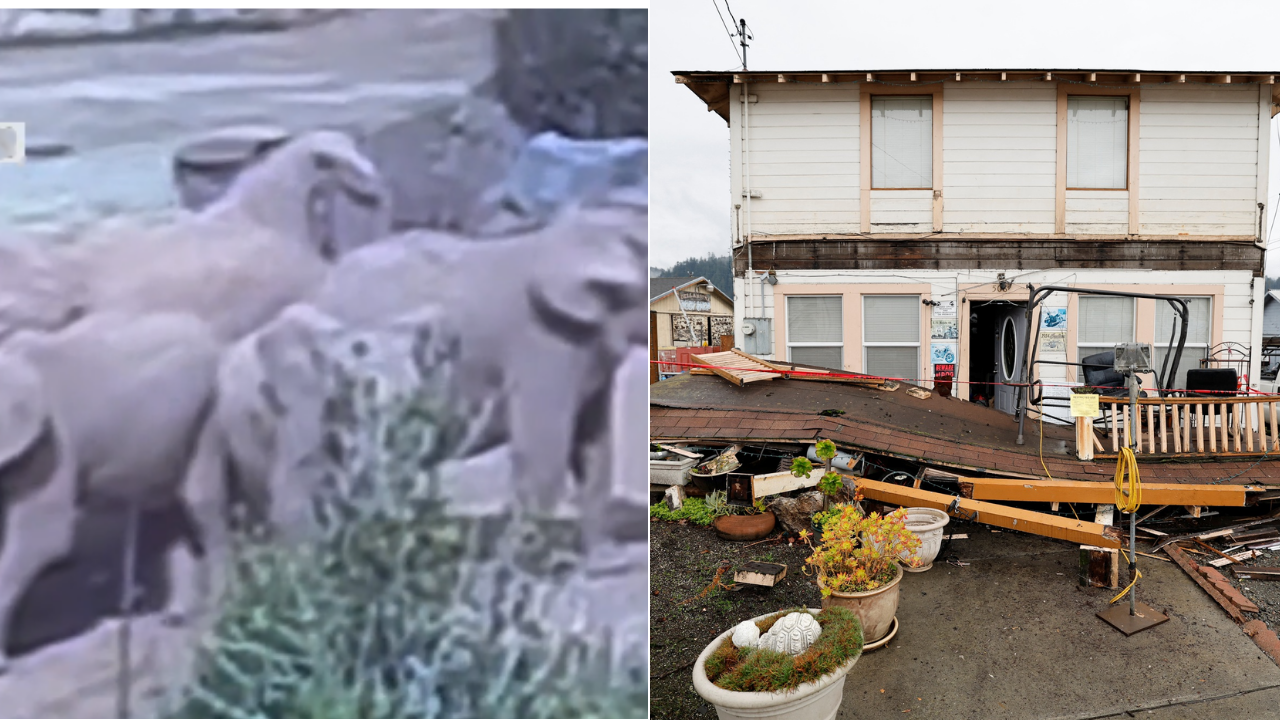In an extraordinary display of animal instinct and unity, a group of elephants at the San Diego Zoo Safari Park left visitors and staff both astonished and deeply moved earlier today when they formed what experts are calling a “warning circle” during a sudden earthquake that shook the area. Just thirty minutes ago, the peaceful morning at the park was interrupted by a mild but noticeable tremor that rattled the grounds, causing a moment of confusion and concern among guests, zookeepers, and, most remarkably, the animals themselves.
As the earth began to subtly shift beneath their feet, a herd of elephants reacted with a behavior that was both astonishingly organized and deeply emotional. Witnesses report that the elephants, rather than running or appearing distressed, gathered together in a tight formation, encircling the youngest and smallest members of their group. Their massive bodies stood firm and protective, creating a living wall around the calves, which were visibly unsettled by the unfamiliar sensation. The sight left visitors in awe, with many quickly pulling out their phones to capture the moment, though the underlying emotion was one of quiet respect rather than curiosity.
This behavior, which animal behaviorists are already describing as a “warning circle,” is believed to be a natural instinct rooted in the elephants’ complex social structure and deep familial bonds. Elephants are known for their extraordinary intelligence, emotional awareness, and ability to sense environmental changes, and this incident provided a powerful reminder of those qualities. The formation is thought to be both a defensive measure and a calming signal to the young elephants, offering them physical safety and emotional reassurance during a moment of uncertainty.
As the tremor subsided, the elephants maintained their protective circle for several more minutes, ears flaring and trunks raised, as if waiting to ensure the danger had fully passed. Zookeepers, some of whom were present during the event, praised the animals for their remarkable self-coordination and remained nearby but chose not to intervene, recognizing the importance of allowing the herd to handle the situation in their own natural way.
A short time later, as the atmosphere settled and the ground stopped shaking, the elephants slowly began to dissolve the circle. Four of the elephants, including two adults and two juveniles, were the first to visibly relax, returning to their usual behaviors of foraging, dust bathing, and social interaction as if nothing out of the ordinary had occurred. The calm return to normalcy was almost as impressive as the initial formation, highlighting the animals’ resilience and finely tuned response to both threat and recovery.
This moment has quickly become a talking point not only within the zoo community but also across social media, where early photos and videos are already circulating. Animal lovers around the world have been left inspired by the depth of care and coordination demonstrated by these elephants, with many calling the scene a powerful reminder of nature’s wisdom and the silent lessons animals offer to humanity.
Officials from the San Diego Zoo Safari Park confirmed that no animals, staff, or visitors were injured during the earthquake and that the elephants are in excellent health following the incident. The quake itself, while noticeable, was described as relatively mild, though it was enough to trigger instinctive reactions in many of the park’s residents, including birds and antelope, who briefly scattered before settling back into their routines. However, none of the other species displayed such a visible and emotionally charged response as the elephants.
This rare event has reignited interest in the study of animal behavior during natural disasters, a field that continues to fascinate scientists. There have long been theories that animals, particularly those as sensitive and socially complex as elephants, are capable of detecting seismic activity before humans are even aware of it. Though today’s tremor struck without significant warning, the elephants’ immediate reaction suggests that their perception of the environment may extend beyond what human senses can register.
For the guests who happened to witness the event, the experience was more than just an unusual sight during a trip to the zoo — it became a touching and unforgettable moment of connection with the animal world. As the sun continued to shine over the park and life resumed its usual rhythm, the image of the elephants standing shoulder to shoulder, protecting the vulnerable members of their herd, served as a quiet but powerful symbol of strength, empathy, and the unspoken bonds that connect all living creatures, even in times of unexpected uncertainty.
